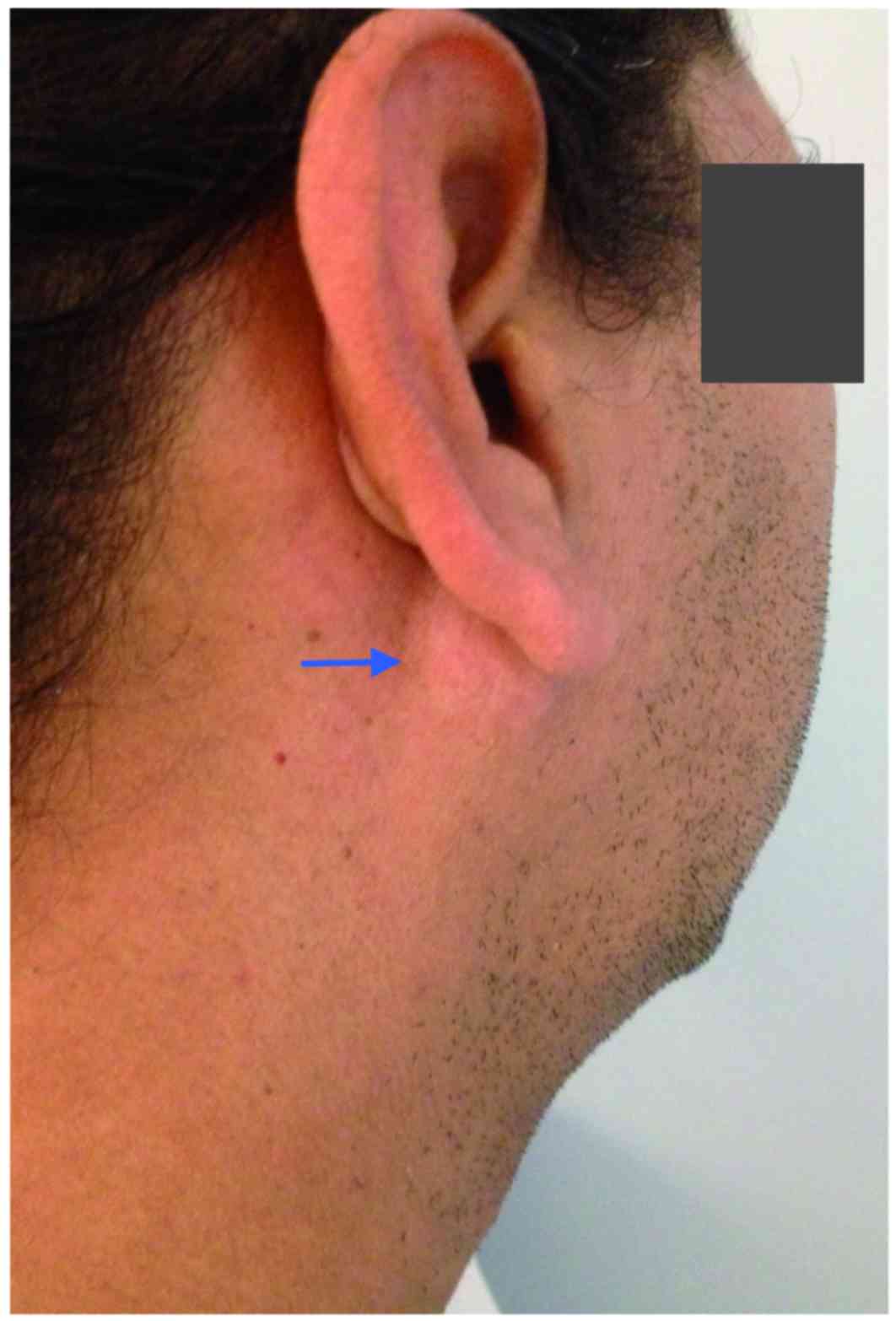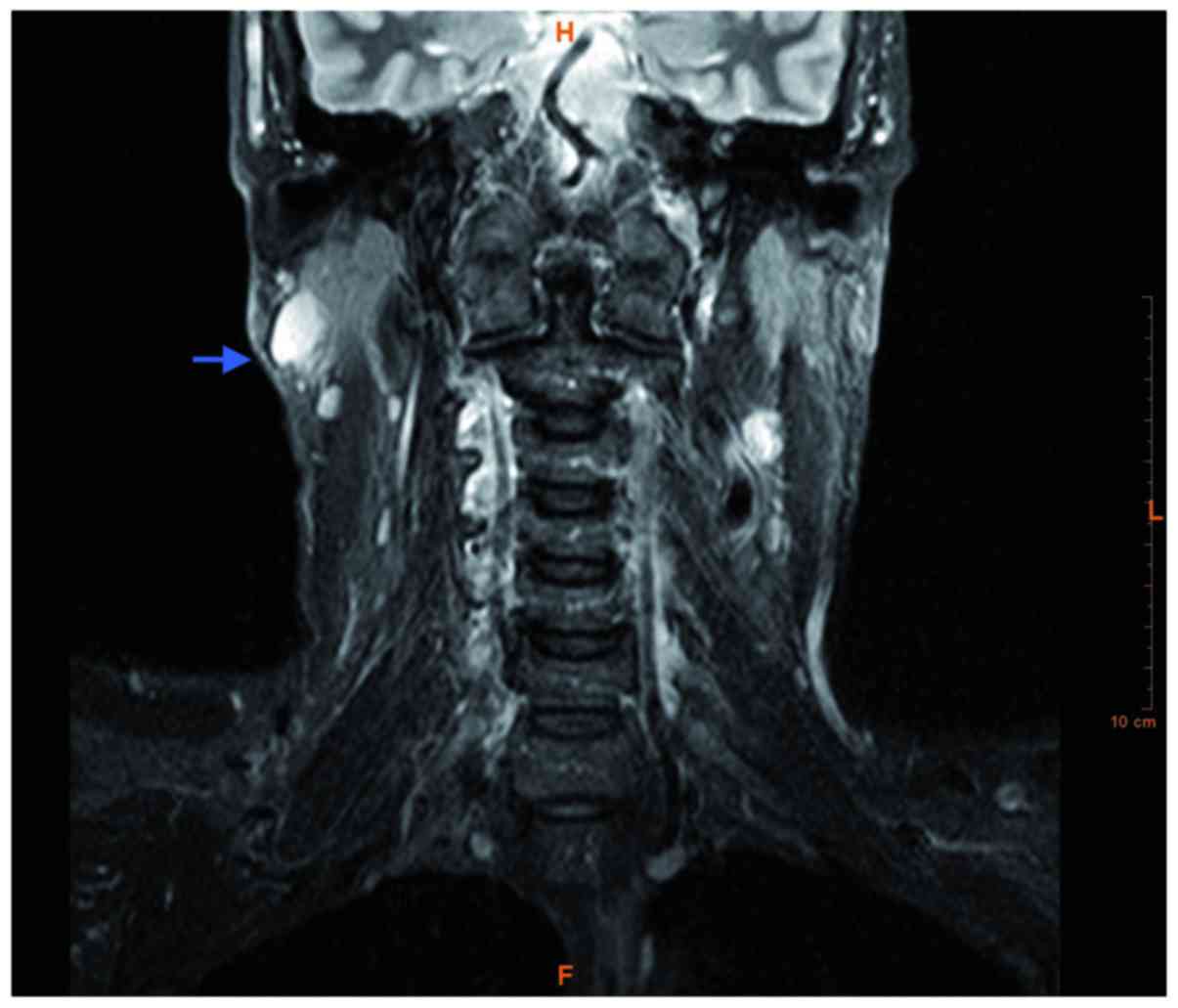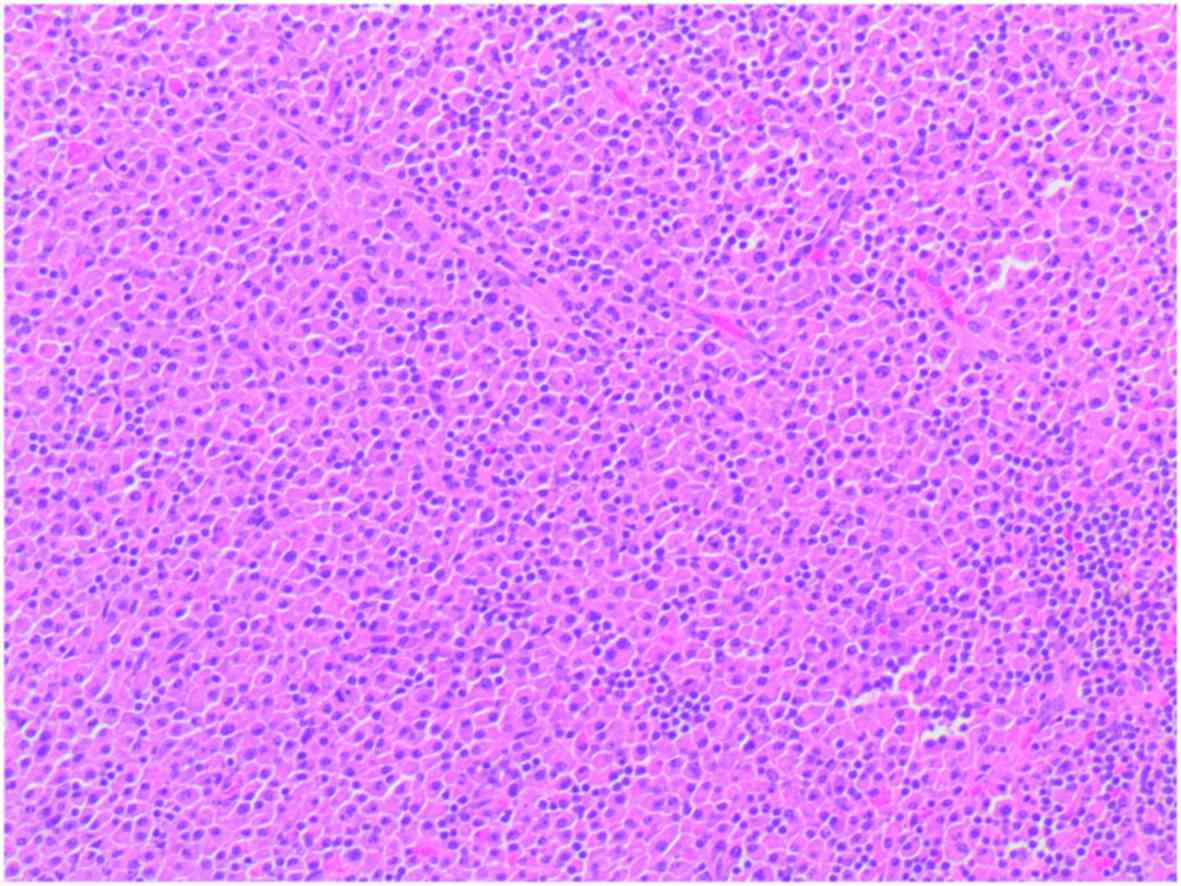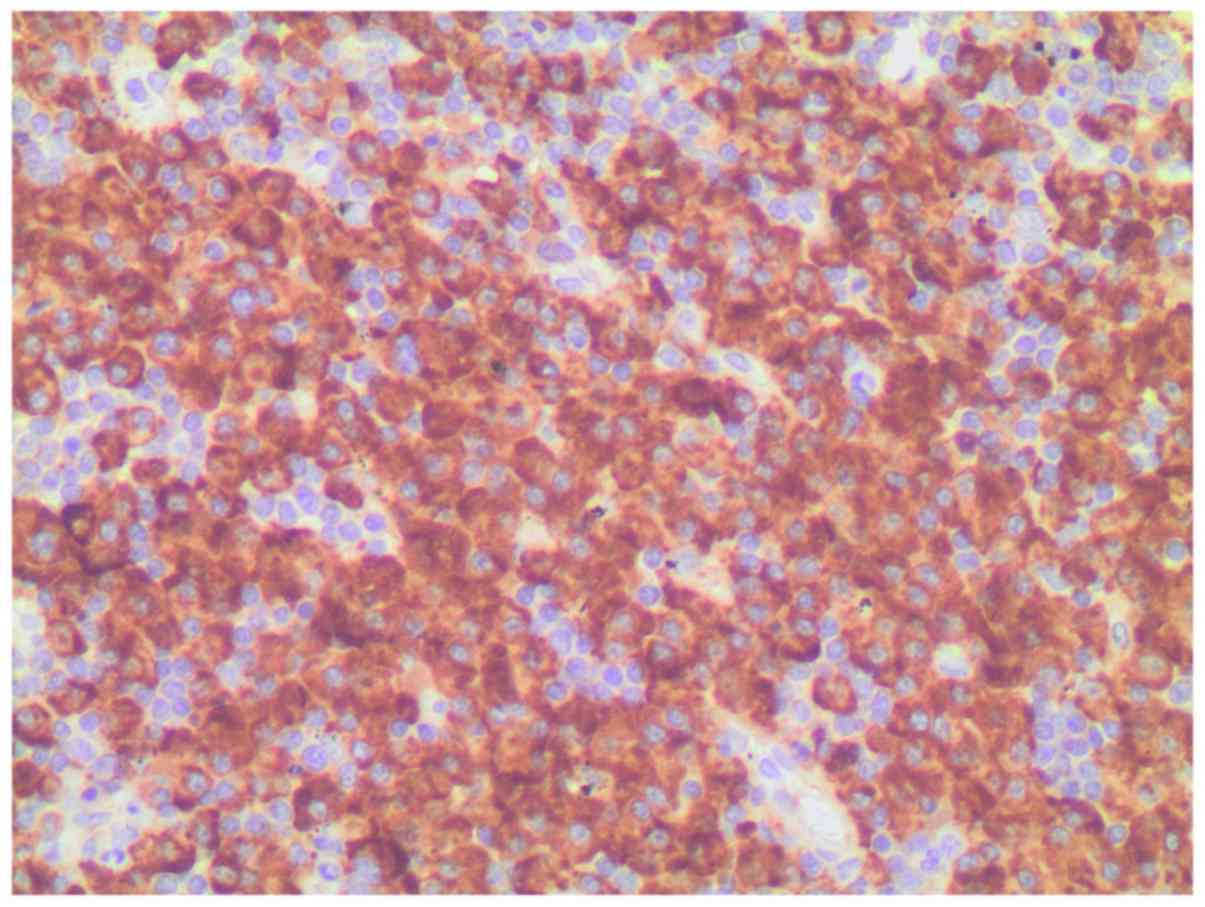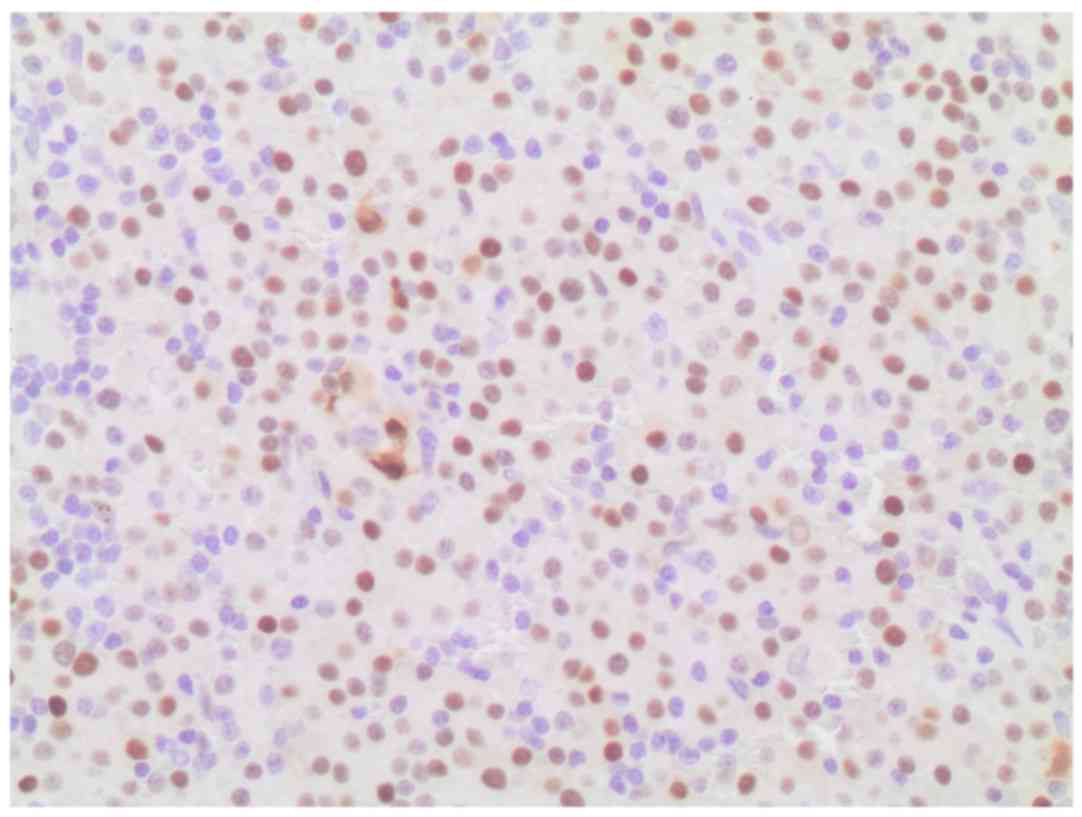
Primary extraosseous plasmacytoma of the parotid gland: A case report and literature review
- Authors:
- Luis Miguel Gonzalez‑Perez
- Pedro Infante‑Cossio
- Juan Jose Borrero‑Martin
View Affiliations
Affiliations: Department of Oral and Maxillofacial Surgery, Virgen del Rocio University Hospital, 41013 Seville, Spain, Department of Pathology, Virgen del Rocio University Hospital, 41013 Seville, Spain
- Published online on: September 19, 2017 https://doi.org/10.3892/mco.2017.1417
-
Pages:
751-754
-
Copyright: © Gonzalez‑Perez
et al. This is an open access article distributed under the
terms of Creative
Commons Attribution License.
Metrics: Total
Views: 0 (Spandidos Publications: | PMC Statistics: )
Metrics: Total PDF Downloads: 0 (Spandidos Publications: | PMC Statistics: )
This article is mentioned in:
Abstract
Extraosseous plasmacytoma (EOP) is an uncommon malignant tumour that is characterised by the monoclonal proliferation of abnormal plasma cells in soft tissue; however, EOP lacks the defining features of multiple myeloma or medullary plasmacytoma. Although the majority of EOP lesions occur in the head and neck, EOP of the parotid gland is extremely uncommon. The present study aimed to explore the clinical features of parotid plasmacytoma, in addition to the diagnostic and therapeutic options for its management. Using the Medline database, a search was conducted for articles published on the topic of ‘parotid plasmacytoma’ up until the year 2016. A total of 20 cases were evaluated, including 19 clinical cases from the literature and 1 new clinical case from our hospital. Among the 19 previously published cases, the mean age at the time of diagnosis of EOP was 65.1±10.9 years (range, 38‑78 years). Plasmacytomas were located unilaterally in all cases: On the right side in 9 patients (47.4%), on the left side in 10 patients (52.6%). Treatment included chemotherapy in 3 cases, radiotherapy in 11 cases and surgical removal in 15 cases. The diagnosis of EOP is based on the presence of a localised tumour comprising monoclonal plasma cells, and EOP is identical to multiple myeloma in this regard; however, EOP, in contrast to multiple myeloma, does not exhibit the signs that are indicative of disseminated disease, such as additional lesions on skeletal radiological examination, plasmacytosis in the bone marrow, and hypercalcaemia, anaemia, or renal failure. Thus, EOP must be considered in the differential diagnosis of parotid gland lesions in order to avoid confusion with other tumoural diseases.
View References
|
1
|
McKenna RW, Kyle RA, Kuehl WM, Grogan TM,
Harris NL and Coupland RW: Plasma Cell NeoplasmsSwerdlow SH, Campo
E and Harris NL: WHO Classification of Tumours of Haematopoietic
and Lymphoid Tissues. Lyon: IARC Press; pp. 200–213. 2008
|
|
2
|
Bachar G, Goldstein D, Brown D, Tsang R,
Lockwood G, Perez-Ordonez B and Irish J: Solitary extramedullary
plasmacytoma of the head and neck-long-term outcome analysis of 68
cases. Head Neck. 30:1012–1019. 2008. View Article : Google Scholar : PubMed/NCBI
|
|
3
|
Vainio-Mattila J: Plasmacytoma of the
parotid gland. Arch Otolaryngol. 82:635–637. 1965. View Article : Google Scholar : PubMed/NCBI
|
|
4
|
Pahor AL: Extramedullary plasmacytoma of
the head and neck, parotid and submandibular salivary glands. J
Laryngol Otol. 91:241–258. 1977. View Article : Google Scholar : PubMed/NCBI
|
|
5
|
Ferlito A, Polidoro F and Recher G:
Extramedullary plasmacytoma of the parotid gland. Laryngoscope.
90:486–493. 1980. View Article : Google Scholar : PubMed/NCBI
|
|
6
|
Kurihara K and Hashimoto N: Extramedullary
plasmacytoma associated with a Castleman's lesion of the cervical
nodes. J Oral Pathol. 12:131–138. 1983. View Article : Google Scholar : PubMed/NCBI
|
|
7
|
Edney JA, Thompson JS, Conley MC and Moore
GE: Plasmacytoma of the parotid gland. J Surg Oncol. 28:165–167.
1985. View Article : Google Scholar : PubMed/NCBI
|
|
8
|
Kanoh T, Hattori N, Uchino H, Fujita A,
Ohmura M and Makimoto K: Extramedullary plasmacytoma of the parotid
gland: Report of a case and review of the literature. Tohoku J Exp
Med. 146:469–478. 1985. View Article : Google Scholar : PubMed/NCBI
|
|
9
|
Ebbers J: Plasmacytoma of the parotid
gland. Laryngol Rhinol Otol (Stuttg). 65:127–129. 1986.(In German).
View Article : Google Scholar : PubMed/NCBI
|
|
10
|
Scholl P and Jafek BW: Extramedullary
plasmacytoma of the parotid gland. Ear Nose Throat J. 65:564–567.
1986.PubMed/NCBI
|
|
11
|
Simi U, Marchetti G, Bruno R, Di Nasso F
and Cardini M: Plasmacytoma of the parotid gland: Report of a case
and review of the world literature. Acta Otorhinolaryngol Belg.
42:93–96. 1988.PubMed/NCBI
|
|
12
|
Rothfield RE, Johnson JT and Stavrides A:
Extramedullary plasmacytoma of the parotid. Head Neck. 12:352–354.
1990. View Article : Google Scholar : PubMed/NCBI
|
|
13
|
Kerr PD and Dort JC: Primary
extramedullary plasmacytoma of the salivary glands. J Laryngol
Otol. 105:687–692. 1991. View Article : Google Scholar : PubMed/NCBI
|
|
14
|
el-Naggar AK, Ordonez NG and Batsakis JG:
Parotid gland plasmacytoma with crystalline deposits. Oral Surg
Oral Med Oral Pathol. 71:206–208. 1991. View Article : Google Scholar : PubMed/NCBI
|
|
15
|
Gonzalez-Garcia J, Ghufoor K, Sandhu G,
Thorpe PA and Hadley J: Primary extramedullary plasmacytoma of the
parotid gland: A case report and review of the literature. J
Laryngol Otol. 112:179–181. 1998. View Article : Google Scholar : PubMed/NCBI
|
|
16
|
Hari CK and Roblin DG: Solitary
plasmacytoma of the parotid gland. Int J Clin Pract. 54:197–198.
2000.PubMed/NCBI
|
|
17
|
Ustun MO, Ekinci N and Payzin B:
Extramedullary plasmacytoma of the parotid gland. Report of a case
with extensive amyloid deposition masking the cytologic and
histopathologic picture. Acta Cytol. 45:449–453. 2001.PubMed/NCBI
|
|
18
|
Kanthan R and Torkian B: Solitary
plasmacytoma of the parotid gland with crystalline inclusions: A
case report. World J Surg Oncol. 1:122003. View Article : Google Scholar : PubMed/NCBI
|
|
19
|
Gouveris H, Hansen T and Franke K:
Solitary extramedullary plasmacytoma and granulomatous sialadenitis
of the parotid gland preceding a B-cell non-Hodgkin's lymphoma.
Mund Kiefer Gesichtschir. 10:122–125. 2006. View Article : Google Scholar : PubMed/NCBI
|
|
20
|
Alabed YZ, Rakheja R and Laufer J:
Solitary extramedullary plasmacytoma of the parotid gland imaged
with 18F-FDG PET/CT. Clin Nucl Med. 39:549–550. 2014. View Article : Google Scholar : PubMed/NCBI
|



